University Crime and Criminal Justice Attitudes Analysis Report
VerifiedAdded on 2020/06/04
|14
|3104
|108
Report
AI Summary
This report analyzes attitudes towards crime and the criminal justice system, examining data from 469 individuals. It reviews existing literature and presents descriptive statistics, including cross-tabulations of respondent opinions based on race. The report formulates and tests two hypotheses using chi-square tests to determine the relationship between race and attitudes towards crime and the handling of criminals by US courts. The findings indicate no statistically significant association between race and opinions on whether enough is being done to fight crime, but a statistically significant association between race and feelings on how US courts handle criminals. The report interprets the results, highlighting the impact of race on perceptions of fairness and trust within the criminal justice system, referencing Cramer's V to assess the strength of relationships. The report concludes by summarizing the key findings and discussing the implications for understanding public attitudes and potential biases within the justice system.
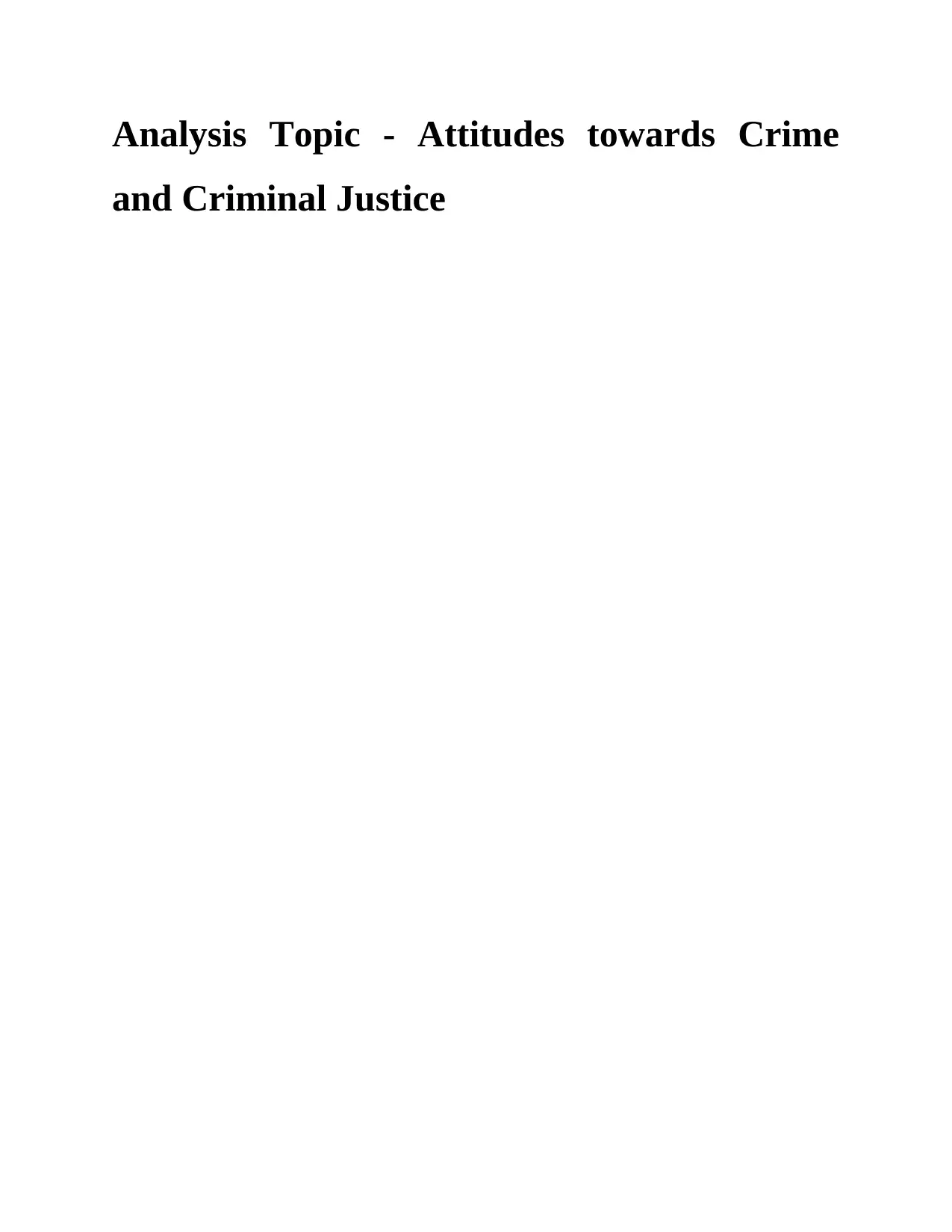
Analysis Topic - Attitudes towards Crime
and Criminal Justice
and Criminal Justice
Paraphrase This Document
Need a fresh take? Get an instant paraphrase of this document with our AI Paraphraser
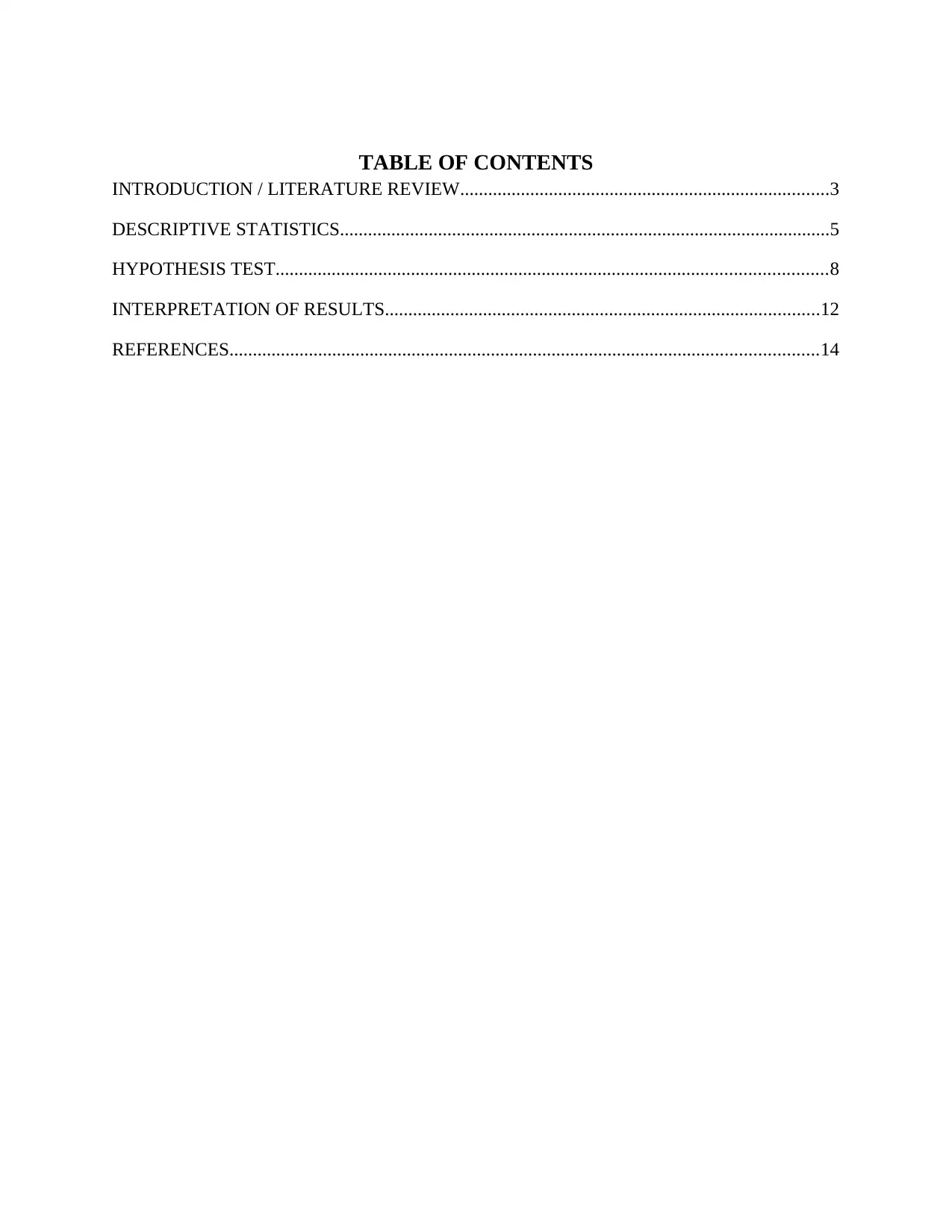
TABLE OF CONTENTS
INTRODUCTION / LITERATURE REVIEW...............................................................................3
DESCRIPTIVE STATISTICS.........................................................................................................5
HYPOTHESIS TEST......................................................................................................................8
INTERPRETATION OF RESULTS.............................................................................................12
REFERENCES..............................................................................................................................14
INTRODUCTION / LITERATURE REVIEW...............................................................................3
DESCRIPTIVE STATISTICS.........................................................................................................5
HYPOTHESIS TEST......................................................................................................................8
INTERPRETATION OF RESULTS.............................................................................................12
REFERENCES..............................................................................................................................14
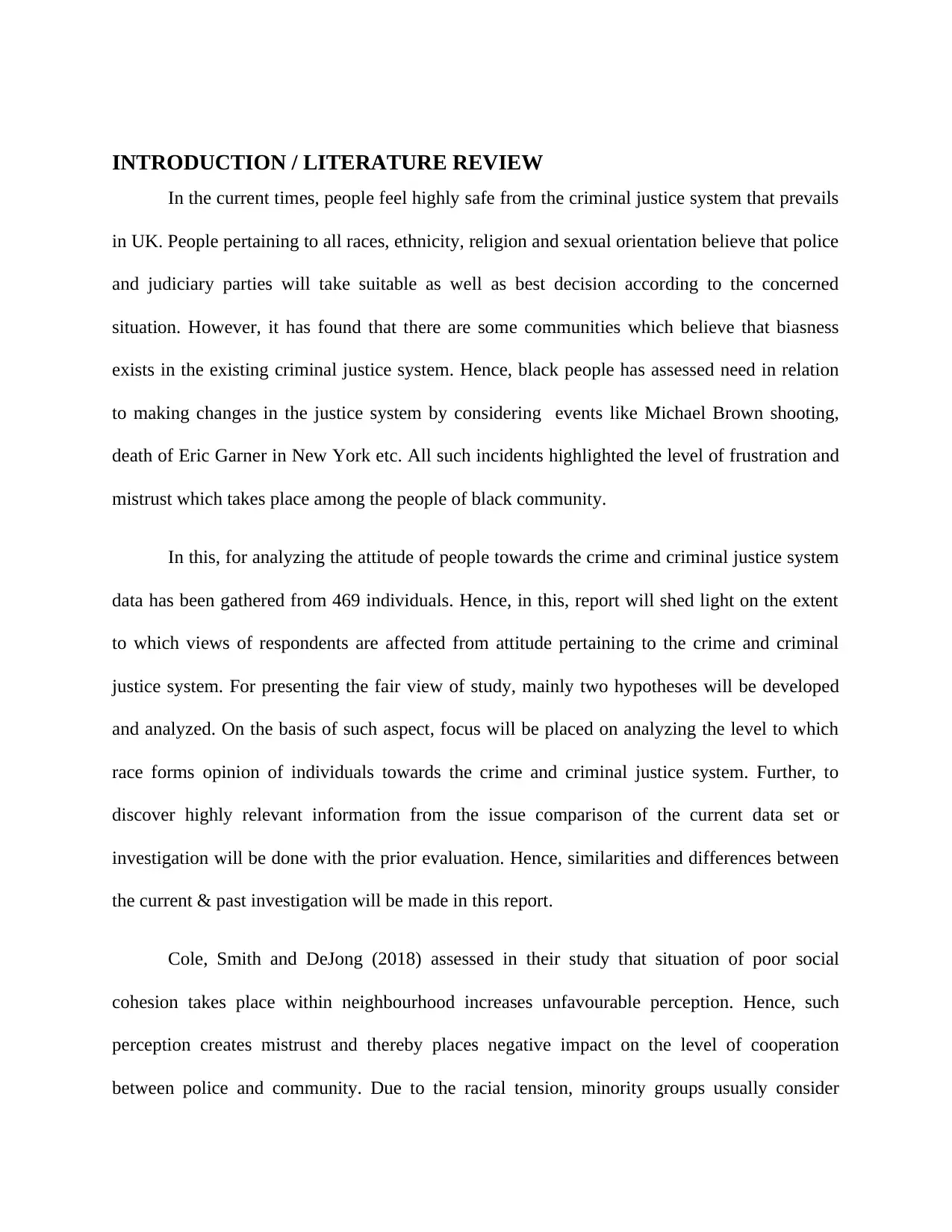
INTRODUCTION / LITERATURE REVIEW
In the current times, people feel highly safe from the criminal justice system that prevails
in UK. People pertaining to all races, ethnicity, religion and sexual orientation believe that police
and judiciary parties will take suitable as well as best decision according to the concerned
situation. However, it has found that there are some communities which believe that biasness
exists in the existing criminal justice system. Hence, black people has assessed need in relation
to making changes in the justice system by considering events like Michael Brown shooting,
death of Eric Garner in New York etc. All such incidents highlighted the level of frustration and
mistrust which takes place among the people of black community.
In this, for analyzing the attitude of people towards the crime and criminal justice system
data has been gathered from 469 individuals. Hence, in this, report will shed light on the extent
to which views of respondents are affected from attitude pertaining to the crime and criminal
justice system. For presenting the fair view of study, mainly two hypotheses will be developed
and analyzed. On the basis of such aspect, focus will be placed on analyzing the level to which
race forms opinion of individuals towards the crime and criminal justice system. Further, to
discover highly relevant information from the issue comparison of the current data set or
investigation will be done with the prior evaluation. Hence, similarities and differences between
the current & past investigation will be made in this report.
Cole, Smith and DeJong (2018) assessed in their study that situation of poor social
cohesion takes place within neighbourhood increases unfavourable perception. Hence, such
perception creates mistrust and thereby places negative impact on the level of cooperation
between police and community. Due to the racial tension, minority groups usually consider
In the current times, people feel highly safe from the criminal justice system that prevails
in UK. People pertaining to all races, ethnicity, religion and sexual orientation believe that police
and judiciary parties will take suitable as well as best decision according to the concerned
situation. However, it has found that there are some communities which believe that biasness
exists in the existing criminal justice system. Hence, black people has assessed need in relation
to making changes in the justice system by considering events like Michael Brown shooting,
death of Eric Garner in New York etc. All such incidents highlighted the level of frustration and
mistrust which takes place among the people of black community.
In this, for analyzing the attitude of people towards the crime and criminal justice system
data has been gathered from 469 individuals. Hence, in this, report will shed light on the extent
to which views of respondents are affected from attitude pertaining to the crime and criminal
justice system. For presenting the fair view of study, mainly two hypotheses will be developed
and analyzed. On the basis of such aspect, focus will be placed on analyzing the level to which
race forms opinion of individuals towards the crime and criminal justice system. Further, to
discover highly relevant information from the issue comparison of the current data set or
investigation will be done with the prior evaluation. Hence, similarities and differences between
the current & past investigation will be made in this report.
Cole, Smith and DeJong (2018) assessed in their study that situation of poor social
cohesion takes place within neighbourhood increases unfavourable perception. Hence, such
perception creates mistrust and thereby places negative impact on the level of cooperation
between police and community. Due to the racial tension, minority groups usually consider
⊘ This is a preview!⊘
Do you want full access?
Subscribe today to unlock all pages.

Trusted by 1+ million students worldwide
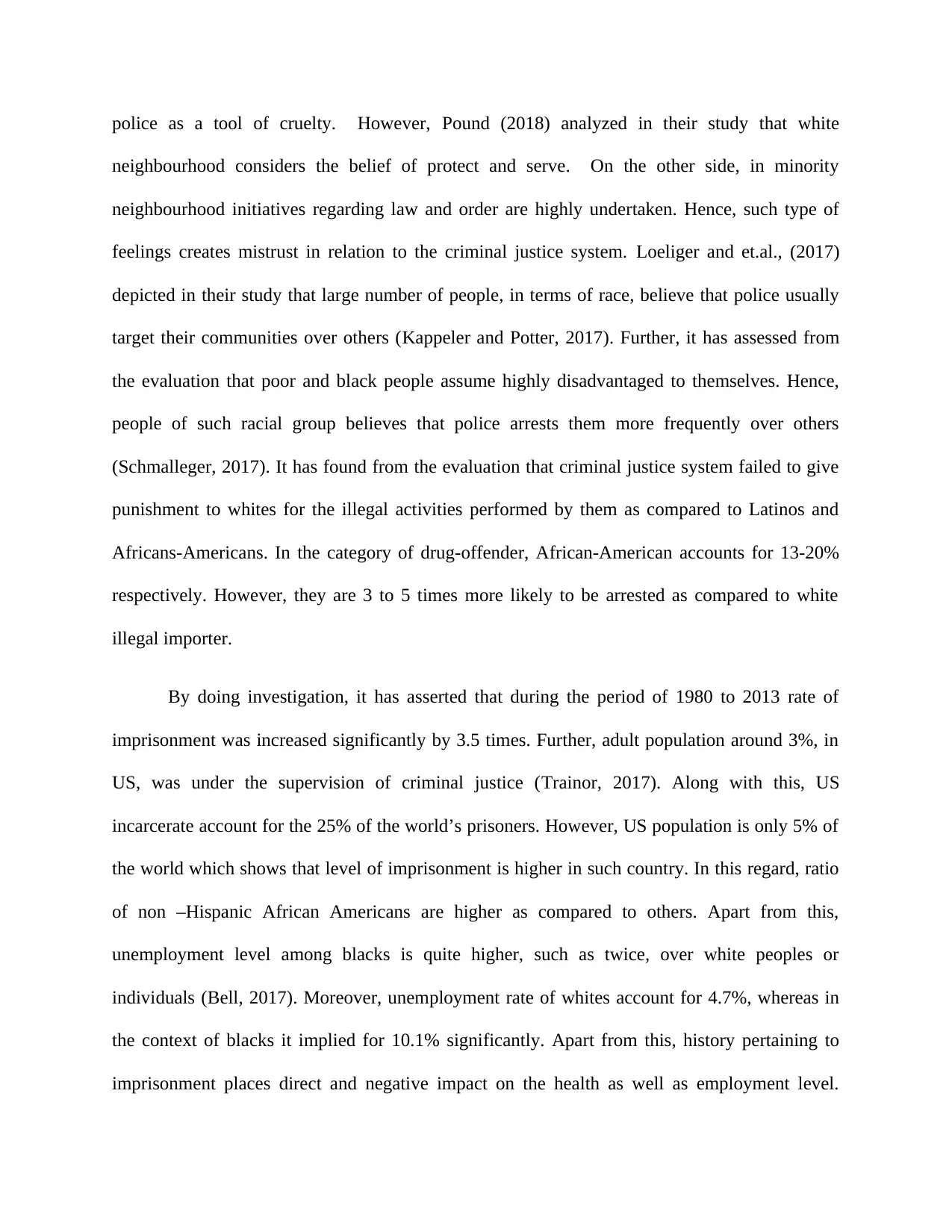
police as a tool of cruelty. However, Pound (2018) analyzed in their study that white
neighbourhood considers the belief of protect and serve. On the other side, in minority
neighbourhood initiatives regarding law and order are highly undertaken. Hence, such type of
feelings creates mistrust in relation to the criminal justice system. Loeliger and et.al., (2017)
depicted in their study that large number of people, in terms of race, believe that police usually
target their communities over others (Kappeler and Potter, 2017). Further, it has assessed from
the evaluation that poor and black people assume highly disadvantaged to themselves. Hence,
people of such racial group believes that police arrests them more frequently over others
(Schmalleger, 2017). It has found from the evaluation that criminal justice system failed to give
punishment to whites for the illegal activities performed by them as compared to Latinos and
Africans-Americans. In the category of drug-offender, African-American accounts for 13-20%
respectively. However, they are 3 to 5 times more likely to be arrested as compared to white
illegal importer.
By doing investigation, it has asserted that during the period of 1980 to 2013 rate of
imprisonment was increased significantly by 3.5 times. Further, adult population around 3%, in
US, was under the supervision of criminal justice (Trainor, 2017). Along with this, US
incarcerate account for the 25% of the world’s prisoners. However, US population is only 5% of
the world which shows that level of imprisonment is higher in such country. In this regard, ratio
of non –Hispanic African Americans are higher as compared to others. Apart from this,
unemployment level among blacks is quite higher, such as twice, over white peoples or
individuals (Bell, 2017). Moreover, unemployment rate of whites account for 4.7%, whereas in
the context of blacks it implied for 10.1% significantly. Apart from this, history pertaining to
imprisonment places direct and negative impact on the health as well as employment level.
neighbourhood considers the belief of protect and serve. On the other side, in minority
neighbourhood initiatives regarding law and order are highly undertaken. Hence, such type of
feelings creates mistrust in relation to the criminal justice system. Loeliger and et.al., (2017)
depicted in their study that large number of people, in terms of race, believe that police usually
target their communities over others (Kappeler and Potter, 2017). Further, it has assessed from
the evaluation that poor and black people assume highly disadvantaged to themselves. Hence,
people of such racial group believes that police arrests them more frequently over others
(Schmalleger, 2017). It has found from the evaluation that criminal justice system failed to give
punishment to whites for the illegal activities performed by them as compared to Latinos and
Africans-Americans. In the category of drug-offender, African-American accounts for 13-20%
respectively. However, they are 3 to 5 times more likely to be arrested as compared to white
illegal importer.
By doing investigation, it has asserted that during the period of 1980 to 2013 rate of
imprisonment was increased significantly by 3.5 times. Further, adult population around 3%, in
US, was under the supervision of criminal justice (Trainor, 2017). Along with this, US
incarcerate account for the 25% of the world’s prisoners. However, US population is only 5% of
the world which shows that level of imprisonment is higher in such country. In this regard, ratio
of non –Hispanic African Americans are higher as compared to others. Apart from this,
unemployment level among blacks is quite higher, such as twice, over white peoples or
individuals (Bell, 2017). Moreover, unemployment rate of whites account for 4.7%, whereas in
the context of blacks it implied for 10.1% significantly. Apart from this, history pertaining to
imprisonment places direct and negative impact on the health as well as employment level.
Paraphrase This Document
Need a fresh take? Get an instant paraphrase of this document with our AI Paraphraser
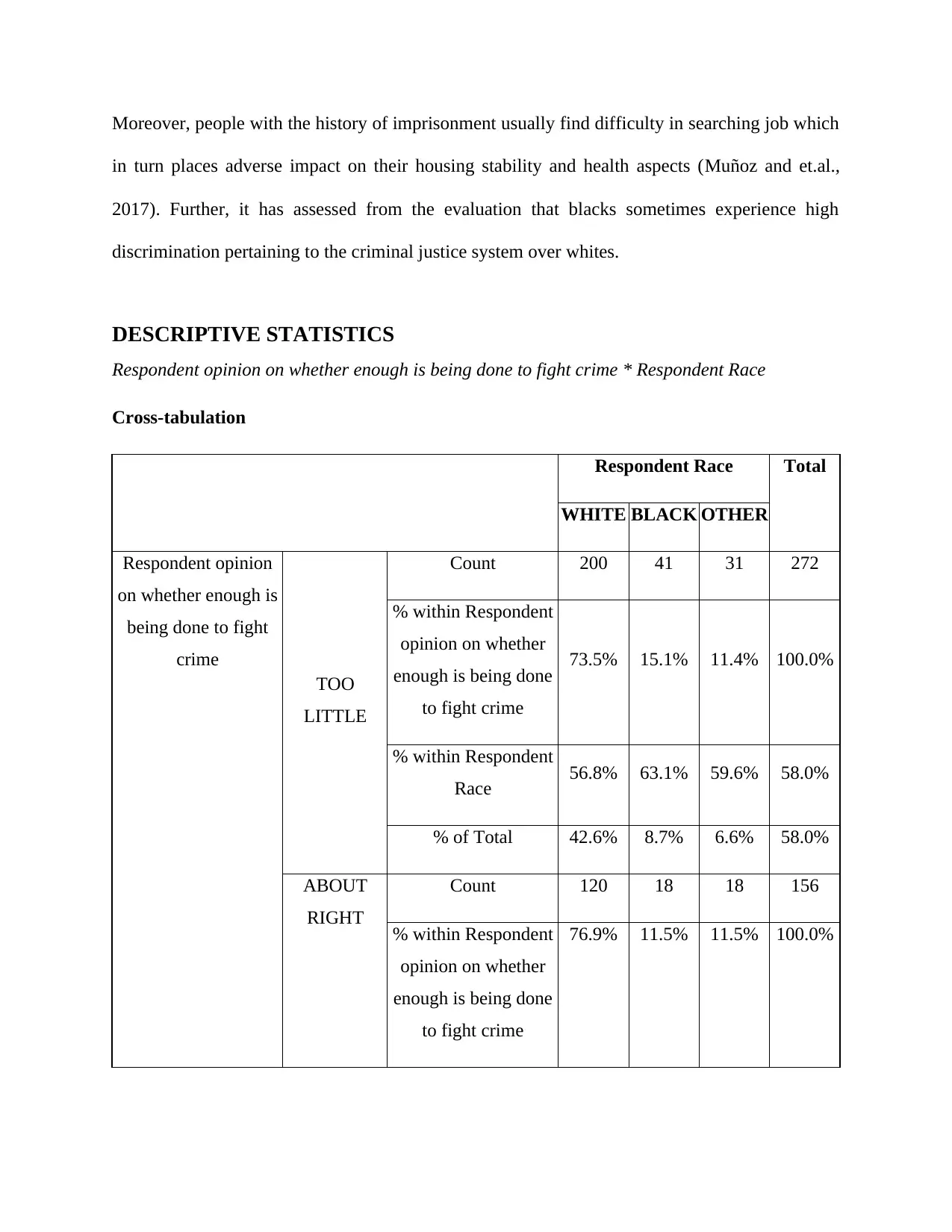
Moreover, people with the history of imprisonment usually find difficulty in searching job which
in turn places adverse impact on their housing stability and health aspects (Muñoz and et.al.,
2017). Further, it has assessed from the evaluation that blacks sometimes experience high
discrimination pertaining to the criminal justice system over whites.
DESCRIPTIVE STATISTICS
Respondent opinion on whether enough is being done to fight crime * Respondent Race
Cross-tabulation
Respondent Race Total
WHITE BLACK OTHER
Respondent opinion
on whether enough is
being done to fight
crime
TOO
LITTLE
Count 200 41 31 272
% within Respondent
opinion on whether
enough is being done
to fight crime
73.5% 15.1% 11.4% 100.0%
% within Respondent
Race 56.8% 63.1% 59.6% 58.0%
% of Total 42.6% 8.7% 6.6% 58.0%
ABOUT
RIGHT
Count 120 18 18 156
% within Respondent
opinion on whether
enough is being done
to fight crime
76.9% 11.5% 11.5% 100.0%
in turn places adverse impact on their housing stability and health aspects (Muñoz and et.al.,
2017). Further, it has assessed from the evaluation that blacks sometimes experience high
discrimination pertaining to the criminal justice system over whites.
DESCRIPTIVE STATISTICS
Respondent opinion on whether enough is being done to fight crime * Respondent Race
Cross-tabulation
Respondent Race Total
WHITE BLACK OTHER
Respondent opinion
on whether enough is
being done to fight
crime
TOO
LITTLE
Count 200 41 31 272
% within Respondent
opinion on whether
enough is being done
to fight crime
73.5% 15.1% 11.4% 100.0%
% within Respondent
Race 56.8% 63.1% 59.6% 58.0%
% of Total 42.6% 8.7% 6.6% 58.0%
ABOUT
RIGHT
Count 120 18 18 156
% within Respondent
opinion on whether
enough is being done
to fight crime
76.9% 11.5% 11.5% 100.0%
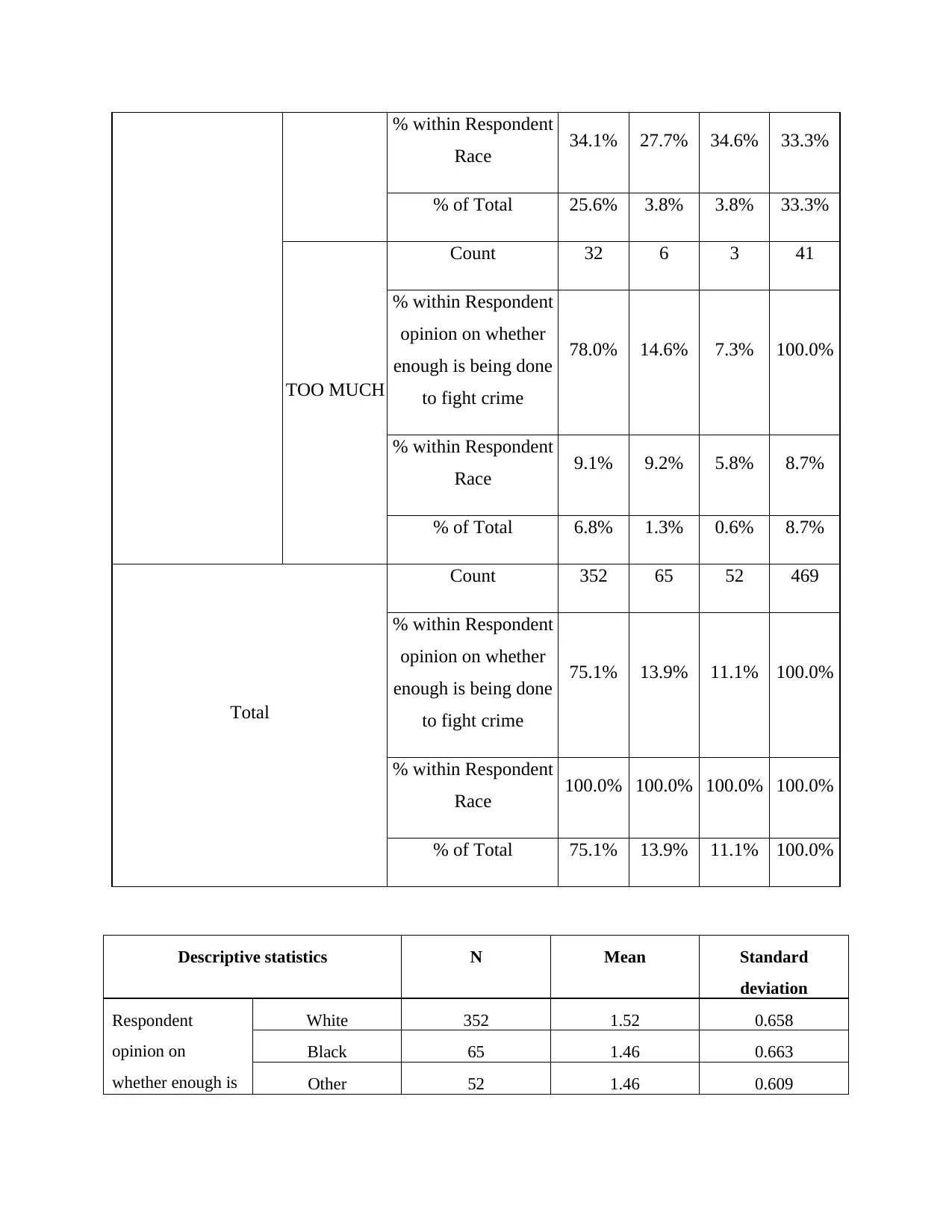
% within Respondent
Race 34.1% 27.7% 34.6% 33.3%
% of Total 25.6% 3.8% 3.8% 33.3%
TOO MUCH
Count 32 6 3 41
% within Respondent
opinion on whether
enough is being done
to fight crime
78.0% 14.6% 7.3% 100.0%
% within Respondent
Race 9.1% 9.2% 5.8% 8.7%
% of Total 6.8% 1.3% 0.6% 8.7%
Total
Count 352 65 52 469
% within Respondent
opinion on whether
enough is being done
to fight crime
75.1% 13.9% 11.1% 100.0%
% within Respondent
Race 100.0% 100.0% 100.0% 100.0%
% of Total 75.1% 13.9% 11.1% 100.0%
Descriptive statistics N Mean Standard
deviation
Respondent
opinion on
whether enough is
White 352 1.52 0.658
Black 65 1.46 0.663
Other 52 1.46 0.609
Race 34.1% 27.7% 34.6% 33.3%
% of Total 25.6% 3.8% 3.8% 33.3%
TOO MUCH
Count 32 6 3 41
% within Respondent
opinion on whether
enough is being done
to fight crime
78.0% 14.6% 7.3% 100.0%
% within Respondent
Race 9.1% 9.2% 5.8% 8.7%
% of Total 6.8% 1.3% 0.6% 8.7%
Total
Count 352 65 52 469
% within Respondent
opinion on whether
enough is being done
to fight crime
75.1% 13.9% 11.1% 100.0%
% within Respondent
Race 100.0% 100.0% 100.0% 100.0%
% of Total 75.1% 13.9% 11.1% 100.0%
Descriptive statistics N Mean Standard
deviation
Respondent
opinion on
whether enough is
White 352 1.52 0.658
Black 65 1.46 0.663
Other 52 1.46 0.609
⊘ This is a preview!⊘
Do you want full access?
Subscribe today to unlock all pages.

Trusted by 1+ million students worldwide
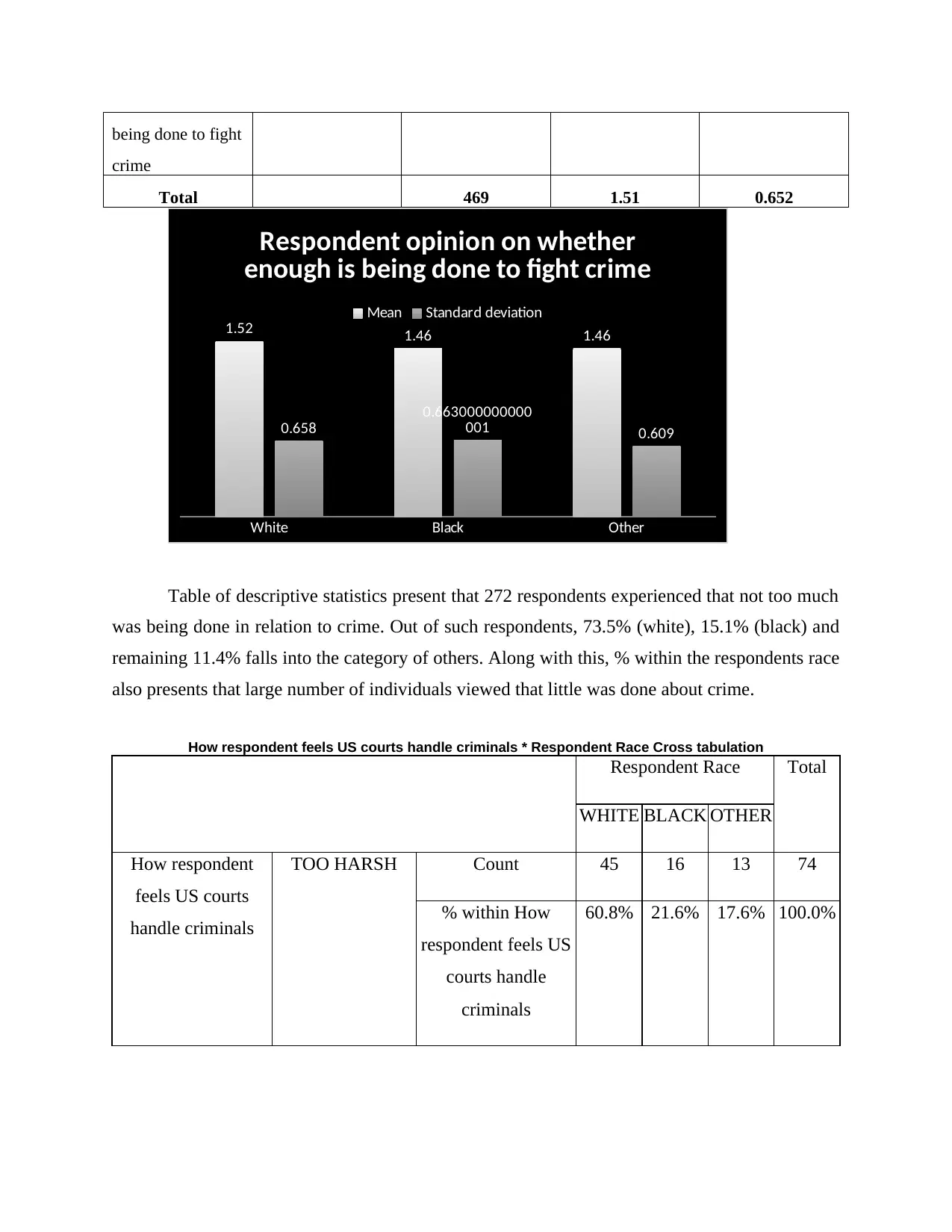
being done to fight
crime
Total 469 1.51 0.652
White Black Other
1.52 1.46 1.46
0.658
0.663000000000
001 0.609
Respondent opinion on whether
enough is being done to fight crime
Mean Standard deviation
Table of descriptive statistics present that 272 respondents experienced that not too much
was being done in relation to crime. Out of such respondents, 73.5% (white), 15.1% (black) and
remaining 11.4% falls into the category of others. Along with this, % within the respondents race
also presents that large number of individuals viewed that little was done about crime.
How respondent feels US courts handle criminals * Respondent Race Cross tabulation
Respondent Race Total
WHITE BLACK OTHER
How respondent
feels US courts
handle criminals
TOO HARSH Count 45 16 13 74
% within How
respondent feels US
courts handle
criminals
60.8% 21.6% 17.6% 100.0%
crime
Total 469 1.51 0.652
White Black Other
1.52 1.46 1.46
0.658
0.663000000000
001 0.609
Respondent opinion on whether
enough is being done to fight crime
Mean Standard deviation
Table of descriptive statistics present that 272 respondents experienced that not too much
was being done in relation to crime. Out of such respondents, 73.5% (white), 15.1% (black) and
remaining 11.4% falls into the category of others. Along with this, % within the respondents race
also presents that large number of individuals viewed that little was done about crime.
How respondent feels US courts handle criminals * Respondent Race Cross tabulation
Respondent Race Total
WHITE BLACK OTHER
How respondent
feels US courts
handle criminals
TOO HARSH Count 45 16 13 74
% within How
respondent feels US
courts handle
criminals
60.8% 21.6% 17.6% 100.0%
Paraphrase This Document
Need a fresh take? Get an instant paraphrase of this document with our AI Paraphraser
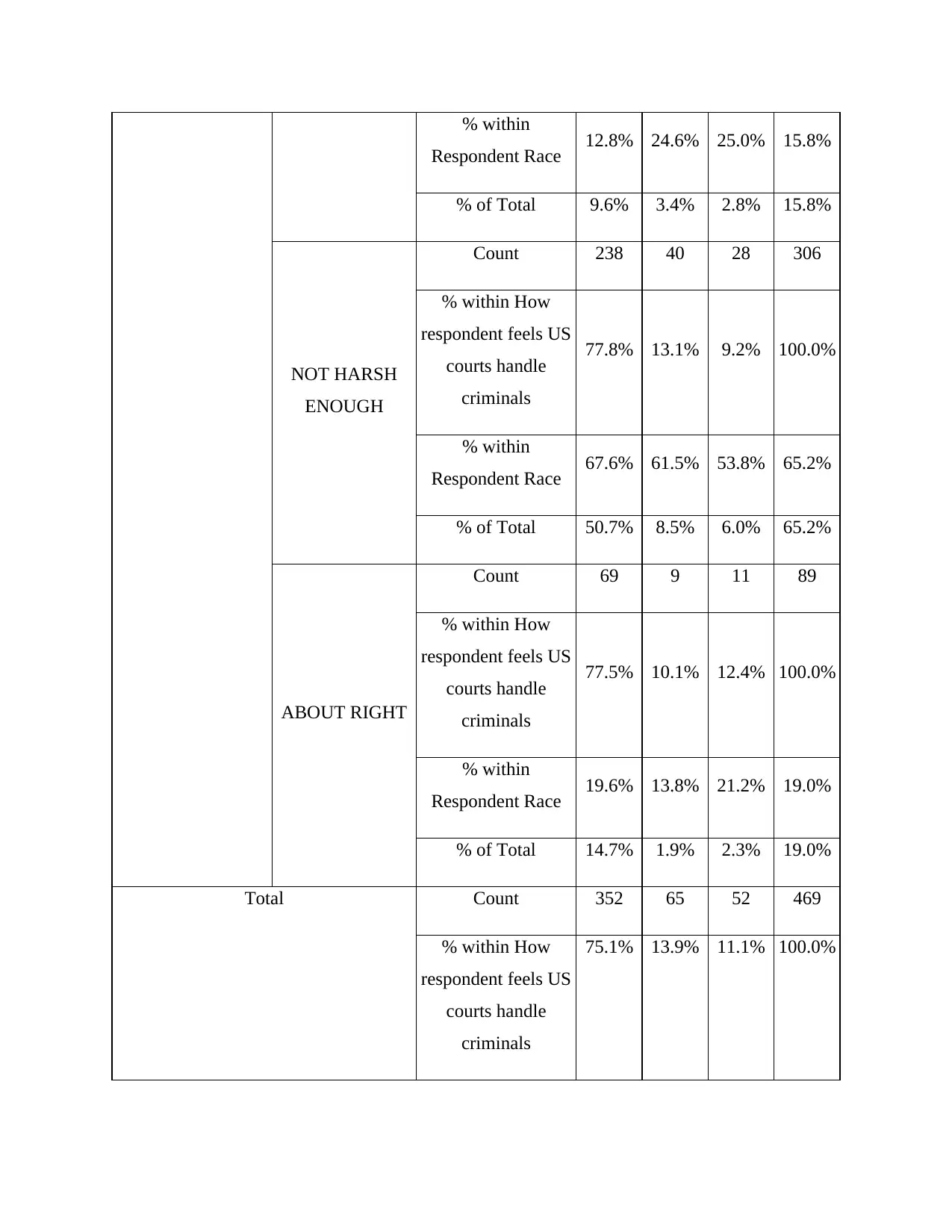
% within
Respondent Race 12.8% 24.6% 25.0% 15.8%
% of Total 9.6% 3.4% 2.8% 15.8%
NOT HARSH
ENOUGH
Count 238 40 28 306
% within How
respondent feels US
courts handle
criminals
77.8% 13.1% 9.2% 100.0%
% within
Respondent Race 67.6% 61.5% 53.8% 65.2%
% of Total 50.7% 8.5% 6.0% 65.2%
ABOUT RIGHT
Count 69 9 11 89
% within How
respondent feels US
courts handle
criminals
77.5% 10.1% 12.4% 100.0%
% within
Respondent Race 19.6% 13.8% 21.2% 19.0%
% of Total 14.7% 1.9% 2.3% 19.0%
Total Count 352 65 52 469
% within How
respondent feels US
courts handle
criminals
75.1% 13.9% 11.1% 100.0%
Respondent Race 12.8% 24.6% 25.0% 15.8%
% of Total 9.6% 3.4% 2.8% 15.8%
NOT HARSH
ENOUGH
Count 238 40 28 306
% within How
respondent feels US
courts handle
criminals
77.8% 13.1% 9.2% 100.0%
% within
Respondent Race 67.6% 61.5% 53.8% 65.2%
% of Total 50.7% 8.5% 6.0% 65.2%
ABOUT RIGHT
Count 69 9 11 89
% within How
respondent feels US
courts handle
criminals
77.5% 10.1% 12.4% 100.0%
% within
Respondent Race 19.6% 13.8% 21.2% 19.0%
% of Total 14.7% 1.9% 2.3% 19.0%
Total Count 352 65 52 469
% within How
respondent feels US
courts handle
criminals
75.1% 13.9% 11.1% 100.0%
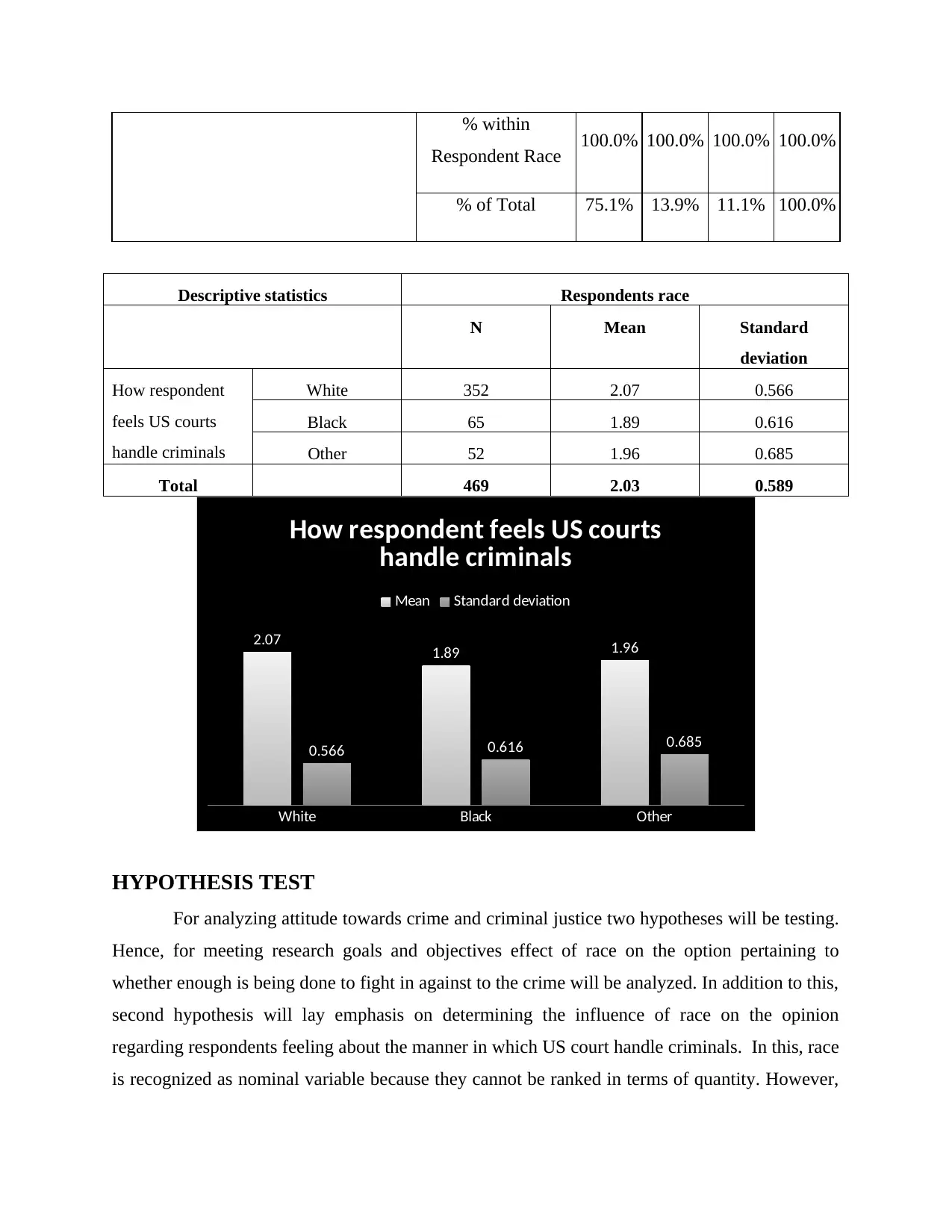
% within
Respondent Race 100.0% 100.0% 100.0% 100.0%
% of Total 75.1% 13.9% 11.1% 100.0%
Descriptive statistics Respondents race
N Mean Standard
deviation
How respondent
feels US courts
handle criminals
White 352 2.07 0.566
Black 65 1.89 0.616
Other 52 1.96 0.685
Total 469 2.03 0.589
White Black Other
2.07 1.89 1.96
0.566 0.616 0.685
How respondent feels US courts
handle criminals
Mean Standard deviation
HYPOTHESIS TEST
For analyzing attitude towards crime and criminal justice two hypotheses will be testing.
Hence, for meeting research goals and objectives effect of race on the option pertaining to
whether enough is being done to fight in against to the crime will be analyzed. In addition to this,
second hypothesis will lay emphasis on determining the influence of race on the opinion
regarding respondents feeling about the manner in which US court handle criminals. In this, race
is recognized as nominal variable because they cannot be ranked in terms of quantity. However,
Respondent Race 100.0% 100.0% 100.0% 100.0%
% of Total 75.1% 13.9% 11.1% 100.0%
Descriptive statistics Respondents race
N Mean Standard
deviation
How respondent
feels US courts
handle criminals
White 352 2.07 0.566
Black 65 1.89 0.616
Other 52 1.96 0.685
Total 469 2.03 0.589
White Black Other
2.07 1.89 1.96
0.566 0.616 0.685
How respondent feels US courts
handle criminals
Mean Standard deviation
HYPOTHESIS TEST
For analyzing attitude towards crime and criminal justice two hypotheses will be testing.
Hence, for meeting research goals and objectives effect of race on the option pertaining to
whether enough is being done to fight in against to the crime will be analyzed. In addition to this,
second hypothesis will lay emphasis on determining the influence of race on the opinion
regarding respondents feeling about the manner in which US court handle criminals. In this, race
is recognized as nominal variable because they cannot be ranked in terms of quantity. However,
⊘ This is a preview!⊘
Do you want full access?
Subscribe today to unlock all pages.

Trusted by 1+ million students worldwide
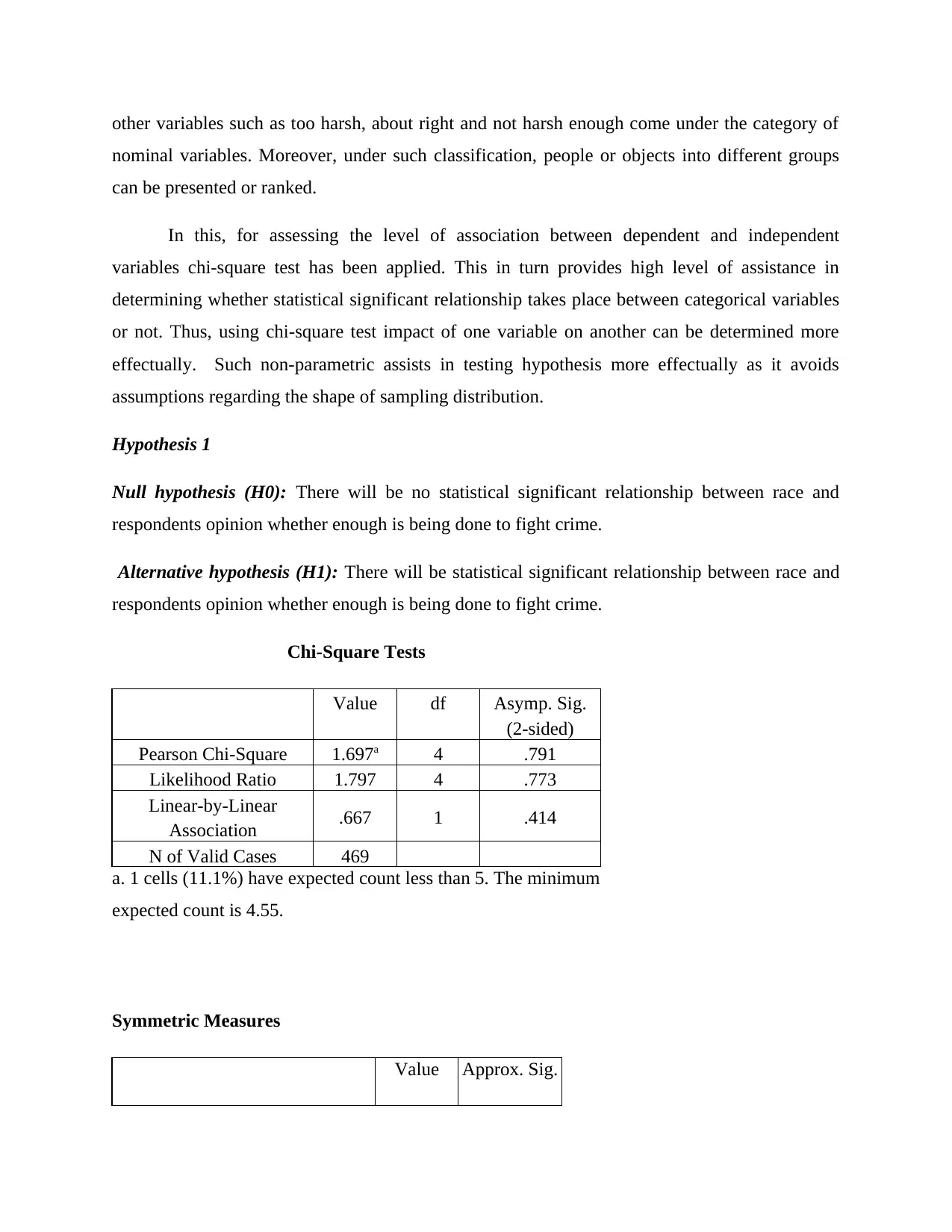
other variables such as too harsh, about right and not harsh enough come under the category of
nominal variables. Moreover, under such classification, people or objects into different groups
can be presented or ranked.
In this, for assessing the level of association between dependent and independent
variables chi-square test has been applied. This in turn provides high level of assistance in
determining whether statistical significant relationship takes place between categorical variables
or not. Thus, using chi-square test impact of one variable on another can be determined more
effectually. Such non-parametric assists in testing hypothesis more effectually as it avoids
assumptions regarding the shape of sampling distribution.
Hypothesis 1
Null hypothesis (H0): There will be no statistical significant relationship between race and
respondents opinion whether enough is being done to fight crime.
Alternative hypothesis (H1): There will be statistical significant relationship between race and
respondents opinion whether enough is being done to fight crime.
Chi-Square Tests
Value df Asymp. Sig.
(2-sided)
Pearson Chi-Square 1.697a 4 .791
Likelihood Ratio 1.797 4 .773
Linear-by-Linear
Association .667 1 .414
N of Valid Cases 469
a. 1 cells (11.1%) have expected count less than 5. The minimum
expected count is 4.55.
Symmetric Measures
Value Approx. Sig.
nominal variables. Moreover, under such classification, people or objects into different groups
can be presented or ranked.
In this, for assessing the level of association between dependent and independent
variables chi-square test has been applied. This in turn provides high level of assistance in
determining whether statistical significant relationship takes place between categorical variables
or not. Thus, using chi-square test impact of one variable on another can be determined more
effectually. Such non-parametric assists in testing hypothesis more effectually as it avoids
assumptions regarding the shape of sampling distribution.
Hypothesis 1
Null hypothesis (H0): There will be no statistical significant relationship between race and
respondents opinion whether enough is being done to fight crime.
Alternative hypothesis (H1): There will be statistical significant relationship between race and
respondents opinion whether enough is being done to fight crime.
Chi-Square Tests
Value df Asymp. Sig.
(2-sided)
Pearson Chi-Square 1.697a 4 .791
Likelihood Ratio 1.797 4 .773
Linear-by-Linear
Association .667 1 .414
N of Valid Cases 469
a. 1 cells (11.1%) have expected count less than 5. The minimum
expected count is 4.55.
Symmetric Measures
Value Approx. Sig.
Paraphrase This Document
Need a fresh take? Get an instant paraphrase of this document with our AI Paraphraser
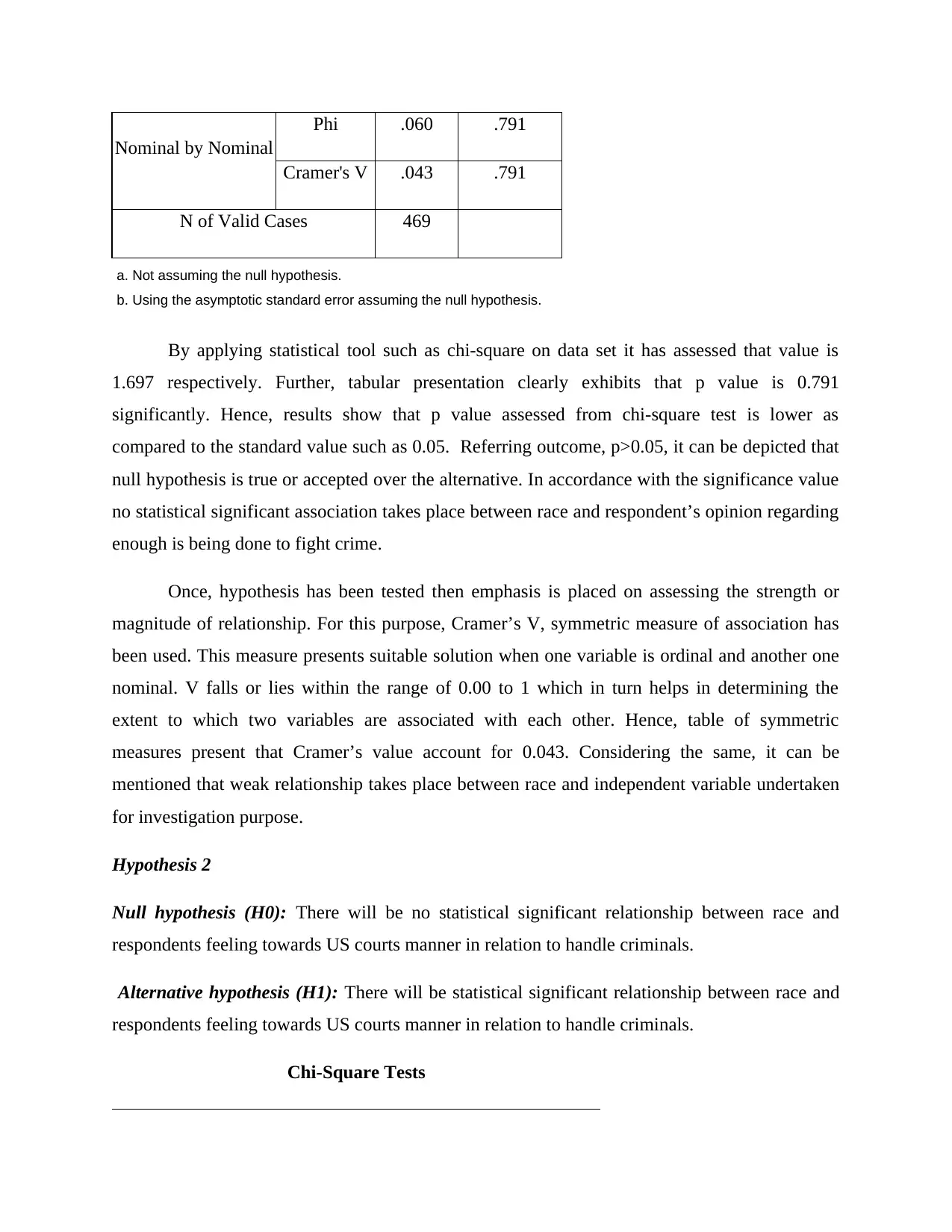
Nominal by Nominal
Phi .060 .791
Cramer's V .043 .791
N of Valid Cases 469
a. Not assuming the null hypothesis.
b. Using the asymptotic standard error assuming the null hypothesis.
By applying statistical tool such as chi-square on data set it has assessed that value is
1.697 respectively. Further, tabular presentation clearly exhibits that p value is 0.791
significantly. Hence, results show that p value assessed from chi-square test is lower as
compared to the standard value such as 0.05. Referring outcome, p>0.05, it can be depicted that
null hypothesis is true or accepted over the alternative. In accordance with the significance value
no statistical significant association takes place between race and respondent’s opinion regarding
enough is being done to fight crime.
Once, hypothesis has been tested then emphasis is placed on assessing the strength or
magnitude of relationship. For this purpose, Cramer’s V, symmetric measure of association has
been used. This measure presents suitable solution when one variable is ordinal and another one
nominal. V falls or lies within the range of 0.00 to 1 which in turn helps in determining the
extent to which two variables are associated with each other. Hence, table of symmetric
measures present that Cramer’s value account for 0.043. Considering the same, it can be
mentioned that weak relationship takes place between race and independent variable undertaken
for investigation purpose.
Hypothesis 2
Null hypothesis (H0): There will be no statistical significant relationship between race and
respondents feeling towards US courts manner in relation to handle criminals.
Alternative hypothesis (H1): There will be statistical significant relationship between race and
respondents feeling towards US courts manner in relation to handle criminals.
Chi-Square Tests
Phi .060 .791
Cramer's V .043 .791
N of Valid Cases 469
a. Not assuming the null hypothesis.
b. Using the asymptotic standard error assuming the null hypothesis.
By applying statistical tool such as chi-square on data set it has assessed that value is
1.697 respectively. Further, tabular presentation clearly exhibits that p value is 0.791
significantly. Hence, results show that p value assessed from chi-square test is lower as
compared to the standard value such as 0.05. Referring outcome, p>0.05, it can be depicted that
null hypothesis is true or accepted over the alternative. In accordance with the significance value
no statistical significant association takes place between race and respondent’s opinion regarding
enough is being done to fight crime.
Once, hypothesis has been tested then emphasis is placed on assessing the strength or
magnitude of relationship. For this purpose, Cramer’s V, symmetric measure of association has
been used. This measure presents suitable solution when one variable is ordinal and another one
nominal. V falls or lies within the range of 0.00 to 1 which in turn helps in determining the
extent to which two variables are associated with each other. Hence, table of symmetric
measures present that Cramer’s value account for 0.043. Considering the same, it can be
mentioned that weak relationship takes place between race and independent variable undertaken
for investigation purpose.
Hypothesis 2
Null hypothesis (H0): There will be no statistical significant relationship between race and
respondents feeling towards US courts manner in relation to handle criminals.
Alternative hypothesis (H1): There will be statistical significant relationship between race and
respondents feeling towards US courts manner in relation to handle criminals.
Chi-Square Tests
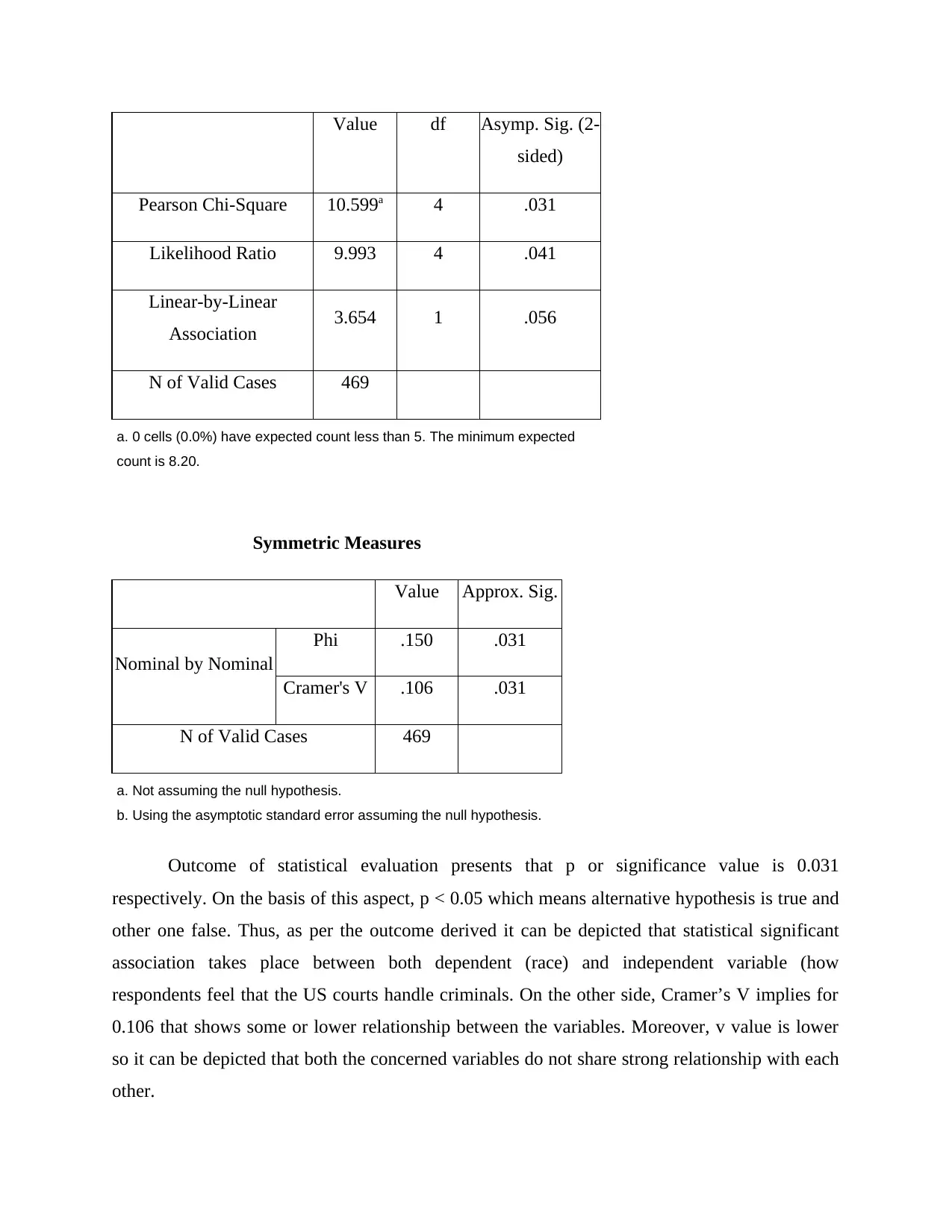
Value df Asymp. Sig. (2-
sided)
Pearson Chi-Square 10.599a 4 .031
Likelihood Ratio 9.993 4 .041
Linear-by-Linear
Association 3.654 1 .056
N of Valid Cases 469
a. 0 cells (0.0%) have expected count less than 5. The minimum expected
count is 8.20.
Symmetric Measures
Value Approx. Sig.
Nominal by Nominal
Phi .150 .031
Cramer's V .106 .031
N of Valid Cases 469
a. Not assuming the null hypothesis.
b. Using the asymptotic standard error assuming the null hypothesis.
Outcome of statistical evaluation presents that p or significance value is 0.031
respectively. On the basis of this aspect, p < 0.05 which means alternative hypothesis is true and
other one false. Thus, as per the outcome derived it can be depicted that statistical significant
association takes place between both dependent (race) and independent variable (how
respondents feel that the US courts handle criminals. On the other side, Cramer’s V implies for
0.106 that shows some or lower relationship between the variables. Moreover, v value is lower
so it can be depicted that both the concerned variables do not share strong relationship with each
other.
sided)
Pearson Chi-Square 10.599a 4 .031
Likelihood Ratio 9.993 4 .041
Linear-by-Linear
Association 3.654 1 .056
N of Valid Cases 469
a. 0 cells (0.0%) have expected count less than 5. The minimum expected
count is 8.20.
Symmetric Measures
Value Approx. Sig.
Nominal by Nominal
Phi .150 .031
Cramer's V .106 .031
N of Valid Cases 469
a. Not assuming the null hypothesis.
b. Using the asymptotic standard error assuming the null hypothesis.
Outcome of statistical evaluation presents that p or significance value is 0.031
respectively. On the basis of this aspect, p < 0.05 which means alternative hypothesis is true and
other one false. Thus, as per the outcome derived it can be depicted that statistical significant
association takes place between both dependent (race) and independent variable (how
respondents feel that the US courts handle criminals. On the other side, Cramer’s V implies for
0.106 that shows some or lower relationship between the variables. Moreover, v value is lower
so it can be depicted that both the concerned variables do not share strong relationship with each
other.
⊘ This is a preview!⊘
Do you want full access?
Subscribe today to unlock all pages.

Trusted by 1+ million students worldwide
1 out of 14
Related Documents
Your All-in-One AI-Powered Toolkit for Academic Success.
+13062052269
info@desklib.com
Available 24*7 on WhatsApp / Email
![[object Object]](/_next/static/media/star-bottom.7253800d.svg)
Unlock your academic potential
Copyright © 2020–2025 A2Z Services. All Rights Reserved. Developed and managed by ZUCOL.




